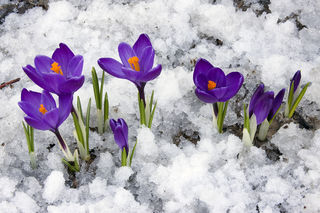
Sex
Growing Old Doesn’t Mean Losing Young
With age, we become men and women of all seasons—old and young and in between.
Posted March 21, 2019

Spring has officially arrived, yet winter and spring continue to play their annual game of tag. While Nature’s seasons are eternal and somewhat orderly, they can also be mercurial and unpredictable. And a similar overlap of seasons occurs in human life.
In many of the world’s myth, the old woman is able to shapeshift into a young maiden and back again, as needed. Author Patricia Monaghan observes, “In the flux of seasons we see each one more than once…. Spring, we fancy, comes to us once, goes once, is gone forever. But [people] spiral though life’s seasons like the [natural] world: there are days of growth in youth, in midlife, in age, just as there are losses and cold in each.” 1
While old and young may appear to be opposites, they actually co-exist. With age, we become men and women of all seasons, at home in each, imprisoned by none. As author Madeleine L’Engle discovered, “The great thing about getting older is that you don’t lose all the other ages you’ve been.”
Current studies in human development suggest that we are many ages at once, and that chronological age is relatively unimportant. Walter Bortz, a professor at the Stanford School of Medicine, for example, observes, “[Chronological] age is becoming increasingly irrelevant to how we live, what we experience, and who we are becoming.”2 Rather than a singular number measured in years, age is increasingly regarded as multi-dimensional, with chronological, biological, cognitive, social, and psychological dimensions. At any one time, we might be chronologically 77, while our other ages could span decades.
The differences between individuals are more pronounced with age, and the older we get, the less alike we become. People age in widely – and sometimes wildly – different ways. In fact, some gerontologists have described today’s older adults as “chronological non-conformists.” This is heartening news for those of us aging in America and other places where growing old is typically, though mistakenly, viewed as an inevitable slide into decrepitude and misery.
One of the reasons for loss-focused view of aging is that the earliest studies of late-life were conducted with elders in hospitals. Decades of more recent research have established that emotional well-being often improves with age and that physical health, cognitive vitality, and passion, commonly thought to atrophy with age, in fact, remain accessible.

Physical and Cognitive Vitality
A growing body of late-life research suggests that most of the physical changes once assumed to be part of the aging process are related to how we live, rather than how long ago we were born. Dr. Mike Evans, for example, writes, “The really exciting thing is that we used to think that problems such as reduced cardiovascular and respiratory function, muscle wasting, and bone loss were just a natural part of aging, but it’s clear now that most are actually the result of inactivity.”3
Most so-called “problems of age” are the consequence of behaviors and attitudes, not chronological age, and can be prevented, delayed, or offset by regular exercise and other health-friendly practices.
There is also mounting evidence that cognitive loss is far less pronounced than previously thought. Information processing speed does slow somewhat, but long-term memory and practical problem solving (sometimes called wisdom) often increase. Most heartening: debilitating cognitive decline is not a normal part of getting older.
The late-life brain has a far greater capacity for continuing development, resilience, and rewiring than early studies suggested. In fact, as Dr. Gene Cohen observes in The Mature Mind, some changes in the aging brain enhance our capacity for contentment and equanimity. (For more on maintaining cognitive vitality in later life, also see Ellen Langer’s Mindfulness and Hansen and Mendius’s Buddha’s Brain.)
Lifelong Passion
Studies also reveal that regular sexual enjoyment is the norm for healthy elders with partners, and that physical intimacy often becomes more satisfying with age. 4 In their extensive study of sexuality in later life, Starr and Weiner note, “As a 72-year-old woman explained, speaking for many of our respondents, ‘Sex is so much more relaxed . . . I know my body better and we know each other better. Sex is unhurried and the best in our lives.’”5
In the majority of tribal and village cultures, sexual activity among elders is expected and tends to occur regularly until very late in life. According to Winn and Newton who studied elders’ sexual behavior in 106 indigenous cultures, women in very late life typically have a greater interest in sex than very old men and often have younger men as partners. 6
In industrialized countries, longitudinal evidence indicates that most healthy, older married couples report continued, regular sexual enjoyment. The primary reasons for a lack of sexual activity among celibate elders are the lack of a partner (especially for women) and poor health, rather than chronological age or a lack of interest in sex. 7
Late-life passion can, of course, take many forms, and sexual activity is only one of them. Many artists and scientists are engaged in some of their most passionate work in the last decades of life or begin new creative endeavors.
As psychologist Dean Simonton points out, “Empirical research actually suggests that creative productivity can undergo a substantial renaissance in the final years, especially toward life’s close. . . .Some time after the late sixties a resurgence in output often appears . . . (contradicting) the supposed inevitability of the downhill slide.”8
As older adults, we have the privilege of enjoying the benefits of age – such as increasing contentment and compassion, a growing sense of kinship with other people and species, an ability to ride the ebbs and flows of life with greater equanimity and humor, and deepening wisdom – while staying connected to our younger selves.
Endnotes
1- Monaghan, Patricia, Seasons of the Witch, 3-4.
2- Bortz, Walter, MD. We Live Too Short and Die Too Long, 199.
3- Evans, Mike, MD. Quoted in Allison, Malorye, ”Improving the Odds,” Harvard Health Letter 16, no. 4 (February 1991): 3-6.
4 Elias, Marilyn. “Late-Life Love,” Harvard Health Letter 18, no.1 (November 1992): 1-3.
5 Starr and Weiner, Sex and Sexuality, 11.
6 Winn and Newton, “Sexuality in Aging,” Archives of Sexual Behavior 11, no.4 (August 1982): 283-98.
7 Starr and Weiner, 13-14, 47-50, and 161-83.
8 Simonton, Dean. “Creative Productivity Through the Adult Years,” Generations 15, no. 2, (Spring 1991): 13-16.



